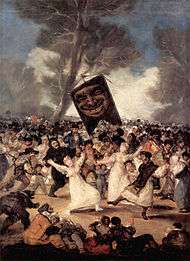Rococo in Spain
In the 18th century, the Spanish Baroque moving towards a more ornate style. Sculpture, painting and carving blend with the architecture, sometimes to encourage classical architectural schemes that remain in force in floors and elevations. Facing the outside, usually austere, are creates vibrant interiors. This late-Baroque which employs profusely ornamental motifs as acanthus leaf, of Classical roots, begins to soak in the 1730s from the influence of French Rococo, exemplified mainly in the dissemination of a new decorative motif: the rocaille (the French rocaille), consisting of complicated sets of "C" and "S" that generate asymmetrical shapes and also remind marine forms. The rocaille became known in Spain through three main ways: dissemination through the pattern books, the importation of furniture and other decorative arts from Europe and its direct brought hand of foreign architects, case of the Portuguese Cayetano de Acosta.
Thus, for the Spanish case it is difficult to speak of the existence of a pure Rococo but, rather, a late-Baroque that borrows elements of the French Rococo. The generic name of Rococo for the Spanish art of the 18th century due to an outdated tendency to consider the Rococo as the logical evolution of the Baroque. Keep in mind that this style was born in France, where the art of the previous century, known as the Grand Siécle was substantially different to the Spanish case, for its character more classicist. Therefore, the style born as rather more like reaction than as an evolution of 17th century French. Moreover, the Rococo is an art eminently bourgeois and secular, difficult to reconcile with the religious art, the most abundant of the Spanish Baroque. This traditional terminological confusion has contributed to the presence in the 18th century Spanish XVIII of Italian architects and solutions brought of Italian Baroque (more moved in ground), but outside the Rococo but confused with it.
However, apart of the questionable footprint of the Rococo in the 18th century Spanish religious art, it is possible to trace some examples of Rococo in Spain, mainly in civil typologies and, especially, in the Court area, at the heat of the new Bourbon dynasty.
Architecture and reredos
In the courtly atmosphere of Madrid are between the most beautiful examples of Spanish Rococo. In the Royal Palace of Madrid, commissioned by Philip V of Spain in 1738, is the superbs Salón de Gasparini and Salón de Porcelana halls. In the same palace found the Salón del Trono hall, an impressive set many examples of rococo furniture as the twelve monumental mirrors accompanied by its respective consoles and the royal throne. In Aranjuez, find a singular piece in the Salón de Porcelana hall of the Royal Palace of Aranjuez, jewel richly decorated at the time of Carlos III of Spain with chinoiserie motifs very appreciate due orientalizing and exotic of the Rococo. Also in the capital of Spain are some temples which are influenced in the Rococo, like Basílica Pontificia de San Miguel, designed by Italian architect Santiago Bonavía in 1739.
In Valencia highlights the Palace of the Marqués de Dos Aguas (1740-1744), with a facade designed by the painter and engraver Hipólito Rovira and executed by Ignacio Vergara y Luis Domingo, certainly one of the key buildings of the Spanish Rococo.
Regarding the architecture of reredos, some of the rereders that were seduced by the rocaille were Narciso Tomé and Portuguese-born Cayetano de Acosta, always working under such a typology characteristic of Spanish Baroque as is the reredo.
Painting
Like 18th century Spanish painters, close to Rococo but of Academicist trend, highlight Luis Egidio Meléndez and Luis Paret y Alcázar; also the Italian Giovanni Battista Tiepolo, who worked in Spain along with Anton Raphael Mengs.
Also highlight the painting works by Antoni Viladomat and Francesc Tramulles i Roig, a Viladomat's disciple and less known because of the ephemeral nature of his work. Francesc Pla i Duran, known as "el Vigatà" showed a slight influence of the Rococo in paintings of the Palau Moja in Barcelona, although the rest of his work have to place it within a Baroque language.
 El Quitasol by Francisco Goya
El Quitasol by Francisco Goya The Entierro de la Sardina (a fiesta), by Francisco de Goya
The Entierro de la Sardina (a fiesta), by Francisco de Goya Charles III dining in presence of his Court by Luis Paret y Alcázar
Charles III dining in presence of his Court by Luis Paret y Alcázar Spring by Antoni Viladomat
Spring by Antoni Viladomat El Majo de la guitarra by Ramón Bayeu. Currently in Museo del Prado
El Majo de la guitarra by Ramón Bayeu. Currently in Museo del Prado Bodegón con trozo de salmón, un limón y tres vasijas by Luis Egidio Meléndez
Bodegón con trozo de salmón, un limón y tres vasijas by Luis Egidio Meléndez Christopher Columbus offering treasures of the Indies to the Catholic Monarchs by Antonio González Velázquez
Christopher Columbus offering treasures of the Indies to the Catholic Monarchs by Antonio González Velázquez Elegant Company Preparing for a Masked Ball by Luis Paret y Alcázar
Elegant Company Preparing for a Masked Ball by Luis Paret y Alcázar Las parejas reales (an equestrian fiesta held in Aranjuez) by Luis Paret y Alcázar in 1770. Currently in Museo del Prado.
Las parejas reales (an equestrian fiesta held in Aranjuez) by Luis Paret y Alcázar in 1770. Currently in Museo del Prado.
External links
| Wikimedia Commons has media related to Rococo art in Spain. |
